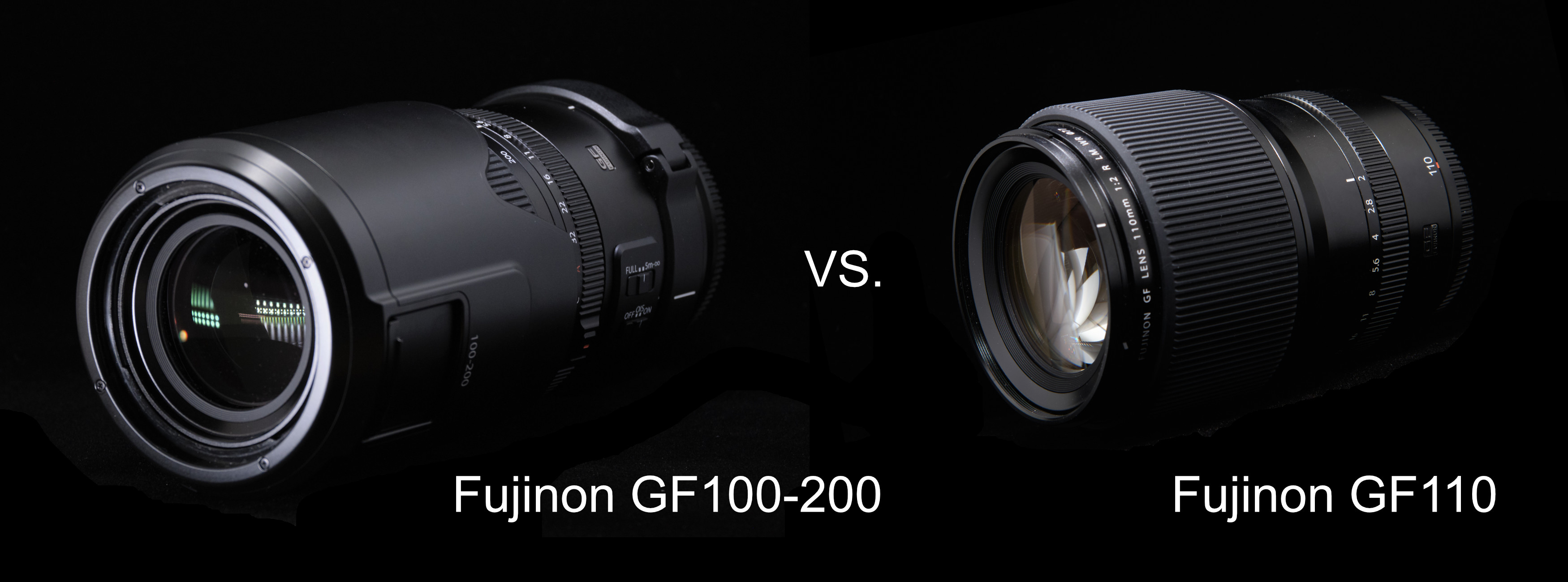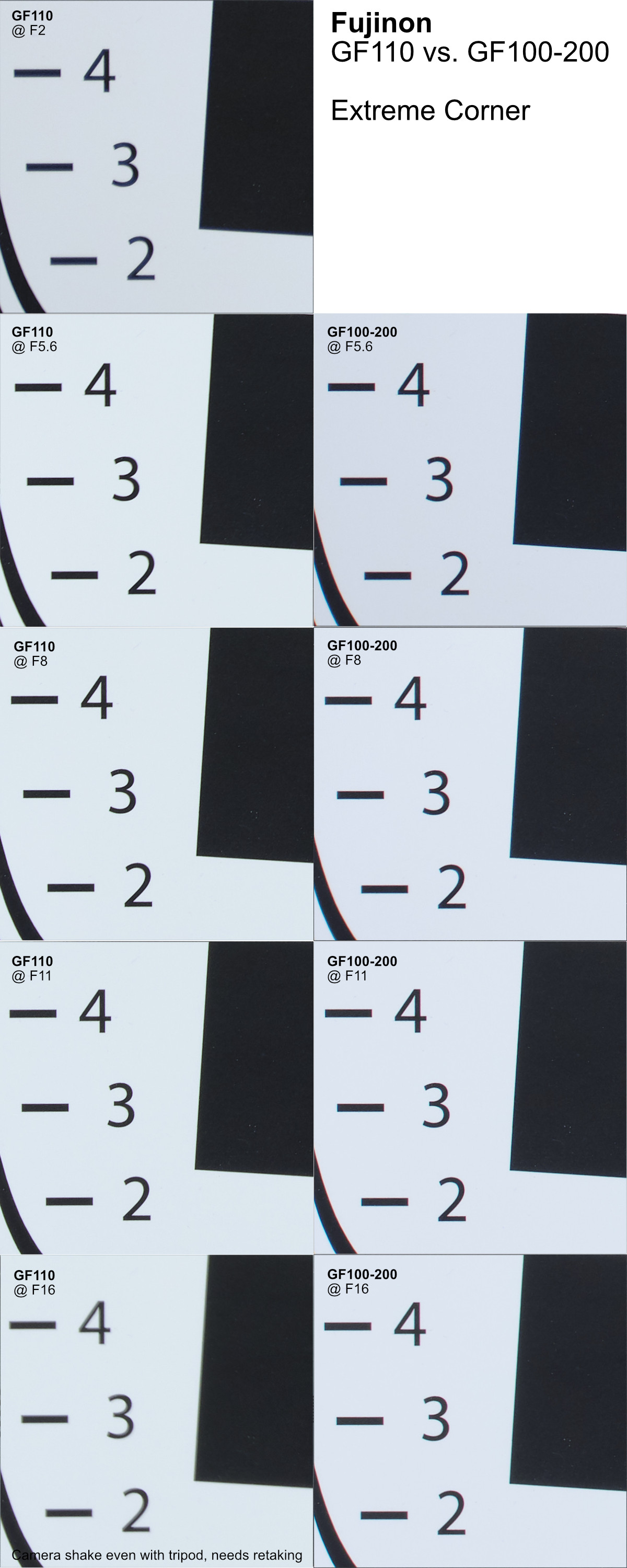I often get asked how the Fujinon GF100-200 compares to the Fujinon GF110 at 110MM. I don’t think this question makes much sense because you buy the GF110 for its wide aperture to make dreamy portraits with that three dimensional look, and you buy the GF100-200 for its light weight and versatility.
They are intended for different purposes so a comparison seems like comparing apples to oranges. However, not a week goes by that I don’t get asked the question or see it asked on the major forums, and I’ve recently used the GF100-200 for environmental portraits with great results, so I thought I would try my best to answer your questions through a quick studio comparison.
A few disclaimers are in order before I present the results:
- Testing a single lens can never be representative of all lenses of the same brand and model; the excellent blog at lensrentals.com demonstrates this time and again when they test 10+ lenses and present the variability
- Precise focus and stable positioning requires a lot of work to ensure the sharpest images are being used for the comparison; without a fixed testing environment, there’s room for errors to be introduced such as the one that invalidated the GF110 F16 data
- The framing of the GF100-200 image was done visually and ended up at 115MM since the camera had a wider field of view when set at exactly 110MM
- Since this test only looks at one focal length within the GF100-200’s range, we cannot extrapolate the results to all focal lengths. Further testing, beyond the scope and capability of this website, would be required to evaluate the lens in its entirety; for more extensive tests, I recommend visiting Jim Kasson’s blog
Results

The reality is that both lenses are excellent with sharpness across the frame for all practical purposes, however the GF110 is truly exceptional. When you view the comparison images below, you may come to the conclusion that the GF100-200 is not sharp in the corners, but for all practical photography purposes, you’ll find the corners to be plenty sharp. I think the comparison however does demonstrate that the GF110 is a really, really special lens.
All images below are scaled at 100% when viewed at full size; to view them at 100%, you may have to download the comparison files, pinch-to-zoom, or double-click the image depending on the browser and platform you are using. The full size JPEG files are linked below so that you can download and view them at the magnification level you prefer.
Center
The GF110 has exceptional contrast and resolution in the centre at all apertures. Even at F2, the contrast is excellent with only a slight reduction in contrast from its peak performance. In comparison, the GF100-200 shows less contrast in the centre than the GF110 across the board, with resolution pretty close.
Stopping down the GF110 results in increased contrast up until F8, whereupon by F11, diffraction starts to come into play. There is an anomaly which I cannot explain at F16 in the GF110 image given that each image was taken the same way using the timer. It appears some camera shake was introduced into the long exposure. The GF100-200 hits its peak at F5.6 and keeps that until F11 when diffraction starts to come into play.

Extreme Corner
The GF110 again has excellent performance with only a bit of contrast and sharpness loss at F2. Between F5.6 and F11, the GF110 is extraordinary in the corners. The same issue that was noted above about camera shake at F16 comes into play here, so that result should be disregarded.
The GF100-200 never quite matches the GF110 in this extreme corner comparison, likely due to the distortion correction I talked about in my GF100-200 review, but it does put on a good showing at all apertures. For real pictures, I doubt you’d notice this very slight loss in resolution. When viewed at 200%, there are however some aberrations that are visible.

Summary
For anyone that has done any research on the Fujinon GF series of lenses, you’ll have heard this before on other review sites, but you really can’t go wrong with any of the Fujinon lenses, they are all superb. However, within superb, if you had to stack-rank the lenses, you’d have to give this one to the GF110.
Having said that, this comparison is really about apples and oranges and both lenses serve a different purpose. I often take both and have been ecstatic with the results. The GF110 is an astounding lens, only limited by the high shutter speed required to keep the images shake-free. The IBIS in the GFX100 will be a perfect partner to this lens.
The GF100-200 is an extremely versatile lens with excellent construction while still being light in weight and modest in size. It is the perfect lens to take on a hike or when traveling. While it can’t quite keep up with the GF110, it holds its own and has earned its spot in my travel kit.
I hope you’ve enjoyed the comparison above. These things always take a lot of time to pull together so I apologize for taking a while to respond to the folks who asked for this comparison back in April. Let me know what you think of the above. Does this match your personal experience with the two lenses?
Download Links
Center comparison (1.4MB)
Extreme corner comparison (0.4MB)
Fujinon GF110 @ F2, F5.6, F8, F11 and F16 (~8MB each)
Fujinon GF100-200 @ F5.6, F8, F11 and F16 (~8MB each)
Discover more from fcracer - Travel & Photography
Subscribe to get the latest posts sent to your email.
Hi
Thanks for your work identifying the real world and laboratory benefits of the GFX lenses. The 45-100 is, so far, in my one month of using the lens, better still than the 100-200mm lens. I would love to see your technical results for that lens. My own sense is that it too, much like the 45mm GFX lens, can be used right up to F 16 before diffraction becomes really noticeable and thus affording quite brilliant depth of field on a MF zoom lens. After an hour playing with the lens, I had no hesitation in trading in the behemoth 250mm lens which, although a beautiful beast, I found myself never carrying generally nor on trips up mountains.
I chuckled at your comparison of the 35mm lenses. I have taken the plunge to experiment with Leica M lenses to use on an M10M with a view to keeping kit in the high mountains low in weight/bulk. I have found the post 2016 Leica summicron 35mm to be much softer than I expected at f2, 2.4 and even 2.8 in the centre. I was hoping it would function like the stellar SL f2 lenses. That is undoubtedly not the case.. I would say that the 45mm is again a startlingly fast AF lens where I am much more confident of getting a sharp image in the centre wide open or a stop away from it than from the Summicron.
There is no doubt that the IBIS and dampened shutter in the GFX100 is a game changer. It is now possible to nonchalantly walk around with a 110mm or the underrated 32-64 and use them like DSLR travel lenses.
Keep up the good and informative work!
Thank you Darrel! The small Summicron has its charm though; the diminutive size and wonderful tactile feel to the focus and aperture rings. I can’t wait for Fujifilm to bring IBIS to the R body styles! Be well and stay safe!